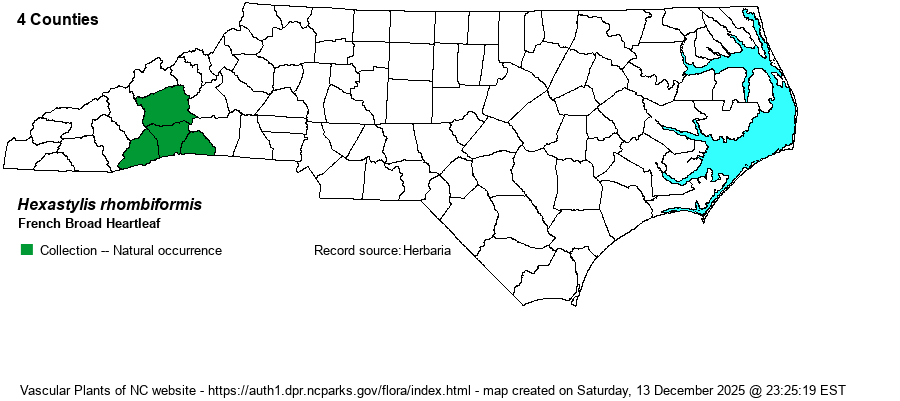| Author | L.L. Gaddy | |
| Distribution | Limited to a small area in the lower Mountains and foothills in the southwestern part of the state, along or close to the Blue Ridge Escarpment; ranging from Buncombe County south to the SC state line. NCNHP reports from Burke County are based only on vegetation plot data and are considered as unreliable, as the editors have no information if flowers were seen, and no specimens or photos of flowers were obtained.
This is a very narrow endemic, ranging only from southwestern NC south into Greenville County, SC. | |
| Abundance | Fairly common in its limited range, at least south of Asheville toward the SC state line from Transylvania to western Polk counties. Very rare in the northern half of Buncombe County, if present that far north. The NCNHP has many dozens of records for the species in its database, but as it is a near-endemic species, NHP tracks it as a Significantly Rare species, even though it has a State Rank of S3. Note also that NatureServe gives it a Global Rank of G3, indicating its global scarcity even if not scarce in parts of the tiny range in NC. | |
| Habitat | As with most others in the genus, this species favors cool, shaded slopes and ravines, this one being normally found very near or under stands of Mountain Laurel (Kalmia latifolia) and/or Rosebay Rhododendron (Rhododendron maximum). It normally occurs in strongly sloping ground, of ravines, bluffs, and other similar situations. | |
| Phenology | Blooms from late March into June, and fruits shortly after flowering. | |
| Identification | This species looks quite similar in leaf to others, having a few thick, shiny, dark green, evergreen leaves with or without some pale veining pattern on the top of the leaves. (Some references state that the leaves are not variegated, but this does not seem to be consistent.) Each leaf is rounded in shape, cordate at the base and with a rounded tip, about 3 inches across and wide. The several brown flowers grow at the base of the plant, generally under leaves or other dead plant material. The calyx is a broad vase-shaped tube about 1 inch long and about 2/3rds a wide as long. As with H. contracta flowers, they are widest just below the middle, narrower somewhat toward the tip, but wider again at the flower tip, with three triangular lobes at the tip of the flower. This species has the flower slightly wider than that found in H. contracta, but the main distinguishing feature is that it has noticeable ridges on the inside of the calyx, as opposed to a nearly flat surface on the inside of the calyx in H. contracta. You may well have to cut open a flower to check the amount and pattern of ridging on the inside, to be certain. But, in many areas within its small range it can be the most common of the heartleaf species encountered, and thus a little bit of exploring in SC border counties can well turn up a population of this plant. | |
| Taxonomic Comments | This is a somewhat recently described species, by L. Gaddy in 1986. Though certainly seen during the days when RAB (1968) was published, it simply was not recognized as being different at that time. It is considered as a good species by essentially all references.
| |
| Other Common Name(s) | None | |
| State Rank | S3 | |
| Global Rank | G3 | |
| State Status | SR-L | |
| US Status | | |
| USACE-agcp | | |
| USACE-emp | | |

